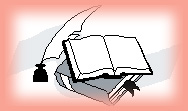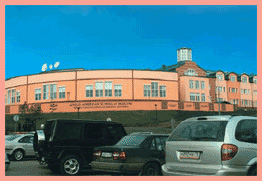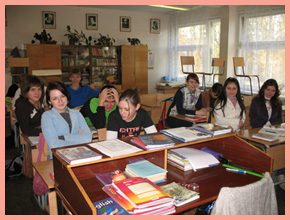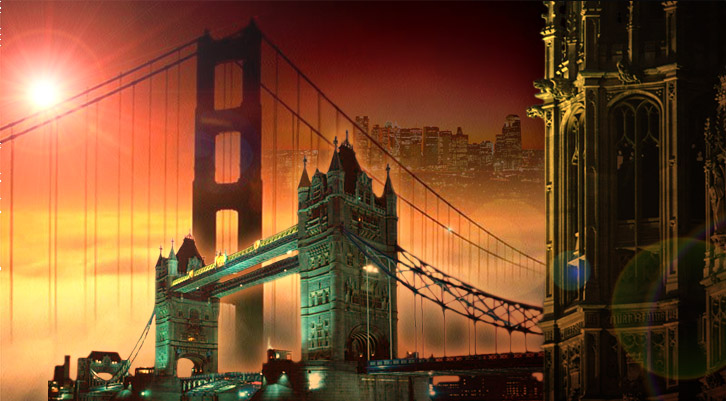| |
 Educated system in Great Britain,
the USA and Russia |
| |
If all good people were clever and all clever people were good, the world would be nicer than ever. I think that education is a key to a good future. And schools are the first step on the education-way. Schools help young people to choose their career, to prepare for their future life, they make pupils clever and well-educated. They give pupils the opportunity to fulfil their talent.
Education in Britain developed by steps. The first step was the introducing of two kinds of school: grammar schools and secondary modern schools. Grammar schools offered a predominantly academic education and in secondary modern schools education was more practical. The second step was the introducing of a new type of school, the comprehensive, a combination of grammar and secondary modern, so that all children could be continually assessed and given appropriate teaching. These school were co-educational and offered both academic and practical subjects. However, they lost the excellence of the old grammar schools. Then after 1979 were introduced the greatest reforms in schooling. They included the introduction of a National Curriculum making certain subjects, most notably science and one modern language, compulsory up to the age of 16. The National Curriculum aims to ensure that all children study essential subjects and have a better all-round education. Pupils' progress in subjects in National Curriculum is measured by written and practical tests. More ambitious pupils continue with very specialized studies in the sixth form. They remain at school for two years more. Pupils sit for exams leaving secondary school and sixth form. They sit for the General Certificate Secondary Education at the end of the 5th-years' course. A-level or AS-levels are taken after two years of study in the sixth form. They are the main standard for entrance to university or other higher education. Some parents prefer to pay for their children to be educated at independent schools. This private sector includes the so-called public schools, some of whose names are known all over the world, for example Eton. It provides exceptionally fine teaching facilities, for example in science, languages, computing and design. Its students are largely from aristocratic and upper-class families. The Government's vision for the education system of the 21st century is that it will neither be divisive nor based on some lowest denominator. Diversity, choice and excellence will be its hallmarks in this century.
 The public educational system in Russia includes pre-schools, general schools, specialised secondary and higher education. So-called pre-schools are kindergartens in fact. Children there learn reading, writing and maths. But pre-school education isn't compulsory - children can get it at home. Compulsory education is for children from 6(7) to 17 years of age. The main branch in the system of education is the general schools which prepare the younger generation for life and work. There are various types of schools: general secondary schools, schools specialising in a certain subject, high schools, gymnasiums and so on. The term of study in a general secondary school is 11 years and consists of primary, middle and upper stages. At the middle stage of a secondary school children learn the basic laws of nature and society at the lessons of history, algebra, literature, physics and many others. After 9th form pupils have to sit for examinations. Also they have a choice between entering the 10th grade of a general secondary school or going to professional school. Pupils who finish the general secondary school, receive a secondary education certificate, giving them the right to enter any higher educational establishment. One has to study in the institute for 5 years. Higher educational institutions train students in one or several specialisations. The public educational system in Russia includes pre-schools, general schools, specialised secondary and higher education. So-called pre-schools are kindergartens in fact. Children there learn reading, writing and maths. But pre-school education isn't compulsory - children can get it at home. Compulsory education is for children from 6(7) to 17 years of age. The main branch in the system of education is the general schools which prepare the younger generation for life and work. There are various types of schools: general secondary schools, schools specialising in a certain subject, high schools, gymnasiums and so on. The term of study in a general secondary school is 11 years and consists of primary, middle and upper stages. At the middle stage of a secondary school children learn the basic laws of nature and society at the lessons of history, algebra, literature, physics and many others. After 9th form pupils have to sit for examinations. Also they have a choice between entering the 10th grade of a general secondary school or going to professional school. Pupils who finish the general secondary school, receive a secondary education certificate, giving them the right to enter any higher educational establishment. One has to study in the institute for 5 years. Higher educational institutions train students in one or several specialisations.
The American system of education differs from the systems of other countries. There are free public schools which the majority of American children attend. There are also a number or private schools where a fee is charged. Education is compulsory for every child from the age of 6 up to the age of 16 except in some states, where children must go to school until the age of 17 or 18. Elementary or primary and secondary or high schools are organized on one of two basis: 8 years of primary school and 4 years, or 6 years of primary, 3 years of junior high school and 3 years of senior high school. The junior high school is a sort of halfway between primary school and high school. The high school prepares young people either to work immediately after graduation or for more advanced study in a college or university. An important part of high school life is extra-curricular activities, they include band or school orchestra, sports and other social activities. There is no national system of higher education in the United States. Instead, there are separate institutions ranging from colleges to universities. They may be small or large, private or public, highly selective or open to all.
|
| |
British education |
I know English boys and girls begin to go to school(it is called "infant") at five; at seven they go to junior schools or departments; at eleven they go to secondary schools. (After selection procedures at the age of eleven they can study at different types of secondary shool: grammar schools which provide an academic education oriented toeards university entry; secondary modern schools which were originally designed to give a general education with a practical bias(уклон); a few secondary technics schools offering a general education related to industry, commerce and agriculture; and schools providing all three or any two types of education, in separately orginized streams known as multilateral or bilateral schools). These schools consist of denominational and non-denominational schools. I'd like to yell you about non-denominational school. One must study there for 6 years. It's open to all boys and girls. There are the six years in this school. During the first year all classes recieve the same basic core of subjects namely English, maths, history, geography, science, French, art, music, P.E., technical subjects & home economics. Toward the end of the second year pupils are asked to make their subject choices for third and forth years.
Desicions on this stage are only taken after interviews involving parents, staff and the pupils themselfs. The curriculum in 3rd and 4th years consistsof compulsory section (обязательное разделение) which includes English, math and an options section made up of those subjects choosen by the pupil at the end of the second year. Optionl cources are designed to give a sound basic education. The system of higher education in Britain includes universities, colleges of education and advanced cources at various colleges. There are more than 44 universities in Britain. But not all universities are equil. They differ from one another in history and tradition. The oldest and world-known universities are Oxford and Cambridge. A university usually consists of colleges. The departments of the colleges are organized into faculties. In the university students have a series of lectures, seminars, tutorials and laboratory classes. Lectures are given to large groups of students while seminars are much smaller than lectures. Lectures and seminars are all one hour in length, laboratory classes last 2 or 3 hours. The academic year devides into 3 terms. First two termslast for 24 weeks; the 3rd term is reserved for classes and examinations and lasts for six weeks. After three years of study a university graduate will leave with the Degree of Bachelor of Arts or Science. Student can continue to take his Master's Degree and then the Doctor's.
|
| |
Education in the USA |
 The American system of school education differs from the systems in other countries. There are state public schools, private elementary schools and private secondary schools. Public schools are free and private schools are fee-paying. Each state has its own system of public schools. Elementary education begins at the age of six or seven, when a child goes to the first grade (form). At the age of sixteen schoolchildren leave the elementary school and may continue their education at one of the secondary schools or high schools, as they call them. The programme of studies in the elementary school includes English, Arithmetic, Geography, History of the USA, Natural sciences and, besides, Physical Training, Singing, Drawing, wood or metal work, etc. Sometimes they learn a foreign language and general history. The American system of school education differs from the systems in other countries. There are state public schools, private elementary schools and private secondary schools. Public schools are free and private schools are fee-paying. Each state has its own system of public schools. Elementary education begins at the age of six or seven, when a child goes to the first grade (form). At the age of sixteen schoolchildren leave the elementary school and may continue their education at one of the secondary schools or high schools, as they call them. The programme of studies in the elementary school includes English, Arithmetic, Geography, History of the USA, Natural sciences and, besides, Physical Training, Singing, Drawing, wood or metal work, etc. Sometimes they learn a foreign language and general history.
Besides giving general education some high schools teach subjects useful to those who hope to find jobs in industry and agriculture or who wants to enter colleges or universities. After graduating from secondary schools a growing number of Americans go on to higher education. The students do not take the same courses. During the first two years they follow a basic programme. It means that every student must select at least one course from each of the basic fields of study: English, Natural sciences, Modern languages, History or Physical education. After the first two years every student can select subjects according to his professional interest. The National Government gives no direct financial aid to the institutions of higher education. Students must pay a tuition fee. This creates a finantial hardship for some people. Many of the students have to work to pay their expenses. Americans place a high value on education. That's why Kennedy said, "Our progress as a nation can be no swifter than our progress in education".
|
| |
Education in Russia |
 Secondary education is mandatory in Russia. Children start school at the age of 6 and finish at 17 . As a rule, a child attends the school located in the neighborhood,the one which is the closes to home . However , there in big cities there are also so-called "special" schools , offering more in-depth studies of the major European languages (English , French, or German), or the advanced courses in physics and mathematics, and children attending one of these may have to commute from home. There are no school buses in Russia. The first stage of education is elementary school for grades 1 through 4. The second is secondary school for grades 5 through 9. Upon graduation from secondary school ( which is not the equivalent of having completed their secondary education ) , students are given the choice of either continuing to attend the same school (high school; grades 10 and 11 ), or entering a vocational school or trade school. Both vocational school and trade schools are meant to provide one , long with the certificate of secondary education, with a number of useful skills ( e.g. , those of an electrician, technical, or computer operator ).One attends the former for two years, and the latter for three or four. Haveing completed one's secondary education, one can either become part of work force or go on to college ( " institution of higher learning " ). There are universityes and so-called "institutes" in Russian . The former stress a more teoretical , fundamental approach to education , while the latter are more practice oriented. There are no medical schools or departments with in the structure of Russian universitys . Future doctors attend medical institutes. There are no degrees in Russian equivalent to those of bachelor's or master's. Students spend approximately five years in college or six in a medical institute. To be admited to an institution of higher learning , one has to pass a series of oral and written tests. Grades in the certificate of secondary education are also taken account. Entry to higher education is quite competitive. Some college departments ( philologist,foreign languages-especially English,law, journalism ) have dozens of applicants for one prospective student's position. The same is true of medical and theatre institutes. Up to the present, neither college students nor schoolchildren have had any say in the selection of courses they had to take. Everyone has studied according to uniform series of guide lines approved by the Ministery of Higher Education . Evidently , this situation is going to change in the near future. Education in Russian has until recently been free on all levels. College students with good grades were rewarded with a modest stipend . All institutions of higher learning were subsidized by the government . Now that the country is changing to a market-place economy, the system of education is also bound to undergo profound changes . The first private scholls , gymnasiums and lycees, have already been founded in Moscow and St. Petersburg , in an attempt to revive the pre-1917 traditionals of Russian educational system with its high standards of excellence. Secondary education is mandatory in Russia. Children start school at the age of 6 and finish at 17 . As a rule, a child attends the school located in the neighborhood,the one which is the closes to home . However , there in big cities there are also so-called "special" schools , offering more in-depth studies of the major European languages (English , French, or German), or the advanced courses in physics and mathematics, and children attending one of these may have to commute from home. There are no school buses in Russia. The first stage of education is elementary school for grades 1 through 4. The second is secondary school for grades 5 through 9. Upon graduation from secondary school ( which is not the equivalent of having completed their secondary education ) , students are given the choice of either continuing to attend the same school (high school; grades 10 and 11 ), or entering a vocational school or trade school. Both vocational school and trade schools are meant to provide one , long with the certificate of secondary education, with a number of useful skills ( e.g. , those of an electrician, technical, or computer operator ).One attends the former for two years, and the latter for three or four. Haveing completed one's secondary education, one can either become part of work force or go on to college ( " institution of higher learning " ). There are universityes and so-called "institutes" in Russian . The former stress a more teoretical , fundamental approach to education , while the latter are more practice oriented. There are no medical schools or departments with in the structure of Russian universitys . Future doctors attend medical institutes. There are no degrees in Russian equivalent to those of bachelor's or master's. Students spend approximately five years in college or six in a medical institute. To be admited to an institution of higher learning , one has to pass a series of oral and written tests. Grades in the certificate of secondary education are also taken account. Entry to higher education is quite competitive. Some college departments ( philologist,foreign languages-especially English,law, journalism ) have dozens of applicants for one prospective student's position. The same is true of medical and theatre institutes. Up to the present, neither college students nor schoolchildren have had any say in the selection of courses they had to take. Everyone has studied according to uniform series of guide lines approved by the Ministery of Higher Education . Evidently , this situation is going to change in the near future. Education in Russian has until recently been free on all levels. College students with good grades were rewarded with a modest stipend . All institutions of higher learning were subsidized by the government . Now that the country is changing to a market-place economy, the system of education is also bound to undergo profound changes . The first private scholls , gymnasiums and lycees, have already been founded in Moscow and St. Petersburg , in an attempt to revive the pre-1917 traditionals of Russian educational system with its high standards of excellence.
|
| |
| |
|


 Educated system in Great Britain,
Educated system in Great Britain, The public educational system in Russia includes pre-schools, general schools, specialised secondary and higher education. So-called pre-schools are kindergartens in fact. Children there learn reading, writing and maths. But pre-school education isn't compulsory - children can get it at home. Compulsory education is for children from 6(7) to 17 years of age. The main branch in the system of education is the general schools which prepare the younger generation for life and work. There are various types of schools: general secondary schools, schools specialising in a certain subject, high schools, gymnasiums and so on. The term of study in a general secondary school is 11 years and consists of primary, middle and upper stages. At the middle stage of a secondary school children learn the basic laws of nature and society at the lessons of history, algebra, literature, physics and many others. After 9th form pupils have to sit for examinations. Also they have a choice between entering the 10th grade of a general secondary school or going to professional school. Pupils who finish the general secondary school, receive a secondary education certificate, giving them the right to enter any higher educational establishment. One has to study in the institute for 5 years. Higher educational institutions train students in one or several specialisations.
The public educational system in Russia includes pre-schools, general schools, specialised secondary and higher education. So-called pre-schools are kindergartens in fact. Children there learn reading, writing and maths. But pre-school education isn't compulsory - children can get it at home. Compulsory education is for children from 6(7) to 17 years of age. The main branch in the system of education is the general schools which prepare the younger generation for life and work. There are various types of schools: general secondary schools, schools specialising in a certain subject, high schools, gymnasiums and so on. The term of study in a general secondary school is 11 years and consists of primary, middle and upper stages. At the middle stage of a secondary school children learn the basic laws of nature and society at the lessons of history, algebra, literature, physics and many others. After 9th form pupils have to sit for examinations. Also they have a choice between entering the 10th grade of a general secondary school or going to professional school. Pupils who finish the general secondary school, receive a secondary education certificate, giving them the right to enter any higher educational establishment. One has to study in the institute for 5 years. Higher educational institutions train students in one or several specialisations.  The American system of school education differs from the systems in other countries. There are state public schools, private elementary schools and private secondary schools. Public schools are free and private schools are fee-paying. Each state has its own system of public schools. Elementary education begins at the age of six or seven, when a child goes to the first grade (form). At the age of sixteen schoolchildren leave the elementary school and may continue their education at one of the secondary schools or high schools, as they call them. The programme of studies in the elementary school includes English, Arithmetic, Geography, History of the USA, Natural sciences and, besides, Physical Training, Singing, Drawing, wood or metal work, etc. Sometimes they learn a foreign language and general history.
The American system of school education differs from the systems in other countries. There are state public schools, private elementary schools and private secondary schools. Public schools are free and private schools are fee-paying. Each state has its own system of public schools. Elementary education begins at the age of six or seven, when a child goes to the first grade (form). At the age of sixteen schoolchildren leave the elementary school and may continue their education at one of the secondary schools or high schools, as they call them. The programme of studies in the elementary school includes English, Arithmetic, Geography, History of the USA, Natural sciences and, besides, Physical Training, Singing, Drawing, wood or metal work, etc. Sometimes they learn a foreign language and general history. Secondary education is mandatory in Russia. Children start school at the age of 6 and finish at 17 . As a rule, a child attends the school located in the neighborhood,the one which is the closes to home . However , there in big cities there are also so-called "special" schools , offering more in-depth studies of the major European languages (English , French, or German), or the advanced courses in physics and mathematics, and children attending one of these may have to commute from home. There are no school buses in Russia. The first stage of education is elementary school for grades 1 through 4. The second is secondary school for grades 5 through 9. Upon graduation from secondary school ( which is not the equivalent of having completed their secondary education ) , students are given the choice of either continuing to attend the same school (high school; grades 10 and 11 ), or entering a vocational school or trade school. Both vocational school and trade schools are meant to provide one , long with the certificate of secondary education, with a number of useful skills ( e.g. , those of an electrician, technical, or computer operator ).One attends the former for two years, and the latter for three or four. Haveing completed one's secondary education, one can either become part of work force or go on to college ( " institution of higher learning " ). There are universityes and so-called "institutes" in Russian . The former stress a more teoretical , fundamental approach to education , while the latter are more practice oriented. There are no medical schools or departments with in the structure of Russian universitys . Future doctors attend medical institutes. There are no degrees in Russian equivalent to those of bachelor's or master's. Students spend approximately five years in college or six in a medical institute. To be admited to an institution of higher learning , one has to pass a series of oral and written tests. Grades in the certificate of secondary education are also taken account. Entry to higher education is quite competitive. Some college departments ( philologist,foreign languages-especially English,law, journalism ) have dozens of applicants for one prospective student's position. The same is true of medical and theatre institutes. Up to the present, neither college students nor schoolchildren have had any say in the selection of courses they had to take. Everyone has studied according to uniform series of guide lines approved by the Ministery of Higher Education . Evidently , this situation is going to change in the near future. Education in Russian has until recently been free on all levels. College students with good grades were rewarded with a modest stipend . All institutions of higher learning were subsidized by the government . Now that the country is changing to a market-place economy, the system of education is also bound to undergo profound changes . The first private scholls , gymnasiums and lycees, have already been founded in Moscow and St. Petersburg , in an attempt to revive the pre-1917 traditionals of Russian educational system with its high standards of excellence.
Secondary education is mandatory in Russia. Children start school at the age of 6 and finish at 17 . As a rule, a child attends the school located in the neighborhood,the one which is the closes to home . However , there in big cities there are also so-called "special" schools , offering more in-depth studies of the major European languages (English , French, or German), or the advanced courses in physics and mathematics, and children attending one of these may have to commute from home. There are no school buses in Russia. The first stage of education is elementary school for grades 1 through 4. The second is secondary school for grades 5 through 9. Upon graduation from secondary school ( which is not the equivalent of having completed their secondary education ) , students are given the choice of either continuing to attend the same school (high school; grades 10 and 11 ), or entering a vocational school or trade school. Both vocational school and trade schools are meant to provide one , long with the certificate of secondary education, with a number of useful skills ( e.g. , those of an electrician, technical, or computer operator ).One attends the former for two years, and the latter for three or four. Haveing completed one's secondary education, one can either become part of work force or go on to college ( " institution of higher learning " ). There are universityes and so-called "institutes" in Russian . The former stress a more teoretical , fundamental approach to education , while the latter are more practice oriented. There are no medical schools or departments with in the structure of Russian universitys . Future doctors attend medical institutes. There are no degrees in Russian equivalent to those of bachelor's or master's. Students spend approximately five years in college or six in a medical institute. To be admited to an institution of higher learning , one has to pass a series of oral and written tests. Grades in the certificate of secondary education are also taken account. Entry to higher education is quite competitive. Some college departments ( philologist,foreign languages-especially English,law, journalism ) have dozens of applicants for one prospective student's position. The same is true of medical and theatre institutes. Up to the present, neither college students nor schoolchildren have had any say in the selection of courses they had to take. Everyone has studied according to uniform series of guide lines approved by the Ministery of Higher Education . Evidently , this situation is going to change in the near future. Education in Russian has until recently been free on all levels. College students with good grades were rewarded with a modest stipend . All institutions of higher learning were subsidized by the government . Now that the country is changing to a market-place economy, the system of education is also bound to undergo profound changes . The first private scholls , gymnasiums and lycees, have already been founded in Moscow and St. Petersburg , in an attempt to revive the pre-1917 traditionals of Russian educational system with its high standards of excellence.